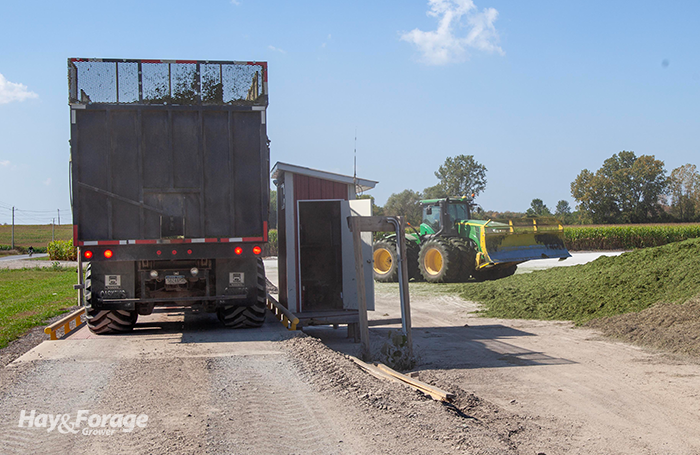
Each fall, millions of acres of corn and soybeans are tallied for yield. For many years, weigh wagons were used to accomplish this task, but now, on-board field monitors do most of the heavy lifting. The point is simply that obtaining on-farm grain yields for just about any hybrid or variety you choose is relatively easy or accessible.
Then there’s alfalfa.
For years, knowing what kind of yields were coming off alfalfa fields was virtually impossible, especially for chopped alfalfa where getting an average bale weight wasn’t an option. Attempts to get such yields usually involved cumbersome weigh pads or having to drive silage wagons to the nearest drive-over scale, which significantly slowed down harvest.
As many dairies started to expand at the turn of the century, on-farm drive-over scales were eventually installed to weigh purchased feedstuffs. These scales also provided the perfect opportunity to get a handle on farm-level forage production.
In 2007, Wisconsin extension educators initiated a project to weigh and sample all alfalfa coming off entire alfalfa fields during their productive life following the establishment year. Participating farms picked the field and simply weighed every load during harvest along with pulling two representative forage samples, which were put in a freezer and later picked up by the local extension educator. It was purposely set up to be easy, but the data generated has been invaluable and enlightening.
Eighteen years after the project’s initiation, data is still being collected with new fields added each year. For most of the project’s life, Midwest Forage Association research grants have covered the forage analysis costs. To date, alfalfa yield and quality data has been collected from 138 different fields across Wisconsin and encompassed 83,590 dry matter (DM) tons harvested from 8,536 acres. Because yields were taken from the same field over its productive life, this project also provides information relative to yield persistence.
Here are some of the long-term results of the study:
• The average total season DM yield was 4.41 tons across the 18 years. The single-year highest average yield was obtained in 2024 at 5.13 tons per acre while the lowest average occurred in 2020 at 3.63 tons per acre.
• The highest single-field total-season yield recorded to date was 6.6 tons per acre.
• The average DM of all harvested chopped forage has been 45% and typically ranged from 40% to 50%.
• The vast majority of fields were harvested four times during the growing season, although there were both three-cut and five-cut fields as well.
• For fields cut four times during the growing season, 36% of the total-season yield was harvested during the first cutting. Second, third, and fourth cuttings provided 25%, 21%, and 18% of the total-season yield, respectively.
• Alfalfa persistence was measured as a percent of the first production year (year after seeding) DM yield. Across years, the second production year provided 102% of the first production year yield total, the third year declined to 94%, and the fourth year stood at 86%. These percentages have improved in more recent years.
• Although forage quality was never a major focus of the project, it was always measured. From 2007 through 2014, the average crude protein of all samples has been 21.7%. The average neutral detergent fiber (NDF) value was 38.6% and NDF digestibility was 49.7%. The average relative forage quality (RFQ) was an impressive 174.
• Aside from the infrequent late fall cutting, first cutting generally provided the highest NDF digestibility (51.2%) of the first four cuttings. Fourth cutting had the highest average RFQ (184) in the four-cut systems, with first cutting close behind (178).
• As might be expected, there has been plenty of year-to-year variation. For example, the average first cutting date for the 18 project years was May 30; however, individual years have ranged from May 16 (2012) to June 10 (2013).
Collecting this type of data for alfalfa is unique to the industry. Because of the year-to-year variation in growing seasons, it is difficult to make good conclusions with only one or two years of data collection. The 18 years (and continuing) of data generated from this project offers a much clearer picture of what is happening on the farm from an alfalfa production perspective.
A more detailed analysis of the Wisconsin Alfalfa Yield and Persistence Project can be found here.

